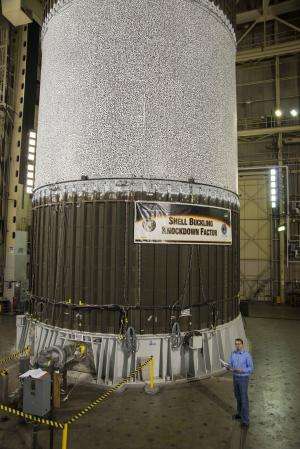NASA engineers crush fuel tank to build better rockets

(Phys.org) —NASA completed a series of high-tech can-crushing tests last week as an enormous fuel tank crumbled under the pressure of almost a million pounds of force, all in the name of building lighter, more affordable rockets.
During the testing for the Shell Buckling Knockdown Factor Project, which began Dec. 9 at NASA's Marshall Space Flight Center in Huntsville, Ala., force and pressure were increasingly applied to the top of an empty but pressurized rocket fuel tank to evaluate its structural integrity. The resulting data will help engineers design, build and test the gigantic fuel tanks for the Space Launch System (SLS) rocket NASA is developing for deep space missions.
"These full-scale tests along with our computer models and subscale tests will help NASA and industry design lighter, more affordable launch vehicles," said Mark Hilburger, senior research engineer in the Structural Mechanics and Concepts Branch at NASA's Langley Research Center in Hampton, Va. Hilburger is conducting the tests for the NASA Engineering and Safety Center. "We were looking at real-time data from 20 cameras and more than 800 sensors during the final test."
The aluminum-lithium tank was made from unused space shuttle tank hardware and decked out in 70,000 black and white polka dots that helped high-speed cameras focus on any buckles, rips or strains.
"When it buckled it was quite dramatic," Hilburger said. "We heard the bang, almost like the sound of thunder and could see the large buckles in the test article."
Engineers are updating design guidelines that have the potential to reduce launch vehicle weight by 20 percent. Lighter rockets can carry more equipment into space or travel farther away from Earth for exploration missions to asteroids, Mars or other distant locations.
"In addition to providing data for the Space Launch System design team, these tests are preparing us for upcoming full-scale tests," said Matt Cash, Marshall's lead test engineer for the shell buckling efforts and the SLS forward skirt and liquid oxygen tank structural testing. "Performing structural tests on hardware that is the same size as SLS hardware is providing tremendous benefit for our future development work for the rocket."
The testing was conducted at Marshall's load test annex, part of the Structural and Dynamics Engineering Test Laboratory previously used to test large structures for the Saturn V rocket, space shuttle and International Space Station.
NASA's Space Launch System will provide an entirely new capability for human exploration beyond Earth orbit. Designed to be flexible for crew or cargo missions, the SLS will be safe, affordable and sustainable to continue America's journey of discovery from the unique vantage point of space. SLS will carry the Orion spacecraft's crew to deep space destinations including an asteroid and eventually Mars.
Provided by NASA


















